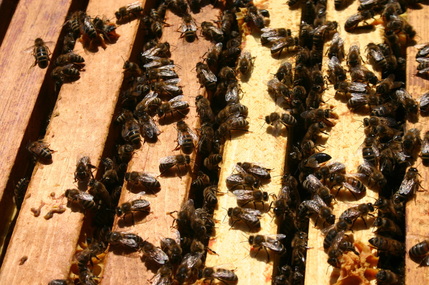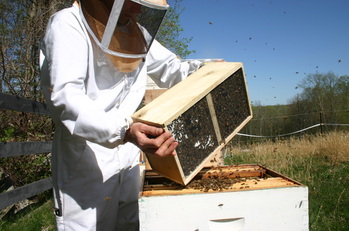
Beekeeping
At the farm we keep a variety of northern raised queens to make sure our bees are strong and ready to make honey when the flow is on. We have a combination of Carniolan, Russian and Northern bred Italians to keep a diverse population. We concentrate on using locally raised queens to increase our over winter survival. Our farm does not use synthetic chemicals to treat our hives. Our honey is pure local honey made from a mix of local wildflowers. We are working towards providing overwintered nucleus colonies for sale.
If you are interested in bees let us know and we are happy to direct you to a local bee club and beekeeping class.
At the farm we keep a variety of northern raised queens to make sure our bees are strong and ready to make honey when the flow is on. We have a combination of Carniolan, Russian and Northern bred Italians to keep a diverse population. We concentrate on using locally raised queens to increase our over winter survival. Our farm does not use synthetic chemicals to treat our hives. Our honey is pure local honey made from a mix of local wildflowers. We are working towards providing overwintered nucleus colonies for sale.
If you are interested in bees let us know and we are happy to direct you to a local bee club and beekeeping class.

The Life of A Bee
There are three types of bees that work in a hive, worker bees, drones, and the queen. The worker bees rotate jobs throughout their lives ending with leaving the hive in search of pollen. The only male bees in the hive are the drones. Their job is to mate with the queen. The queen's job is to lay eggs and keep the hive population up. In the pictures below the worker bees are in their babysitting stage of life. They will tend to the eggs laid by the queen to ensure they grow up strong and healthy. The difference between the bees can be tricky to spot. The honey bee that is most likely seen in your yard is the female worker. The drone is similar to the worker but lacks a stinger. The Queen is the easiest to distinguish. Her body is longer than the average workers and has little to no fuzz on her back. If you look closely you can see the small white larva that is the baby bees and the honey there to feed them. The yellow bumps on the frame are called caps and are to keep the honey safe for future use.
There are three types of bees that work in a hive, worker bees, drones, and the queen. The worker bees rotate jobs throughout their lives ending with leaving the hive in search of pollen. The only male bees in the hive are the drones. Their job is to mate with the queen. The queen's job is to lay eggs and keep the hive population up. In the pictures below the worker bees are in their babysitting stage of life. They will tend to the eggs laid by the queen to ensure they grow up strong and healthy. The difference between the bees can be tricky to spot. The honey bee that is most likely seen in your yard is the female worker. The drone is similar to the worker but lacks a stinger. The Queen is the easiest to distinguish. Her body is longer than the average workers and has little to no fuzz on her back. If you look closely you can see the small white larva that is the baby bees and the honey there to feed them. The yellow bumps on the frame are called caps and are to keep the honey safe for future use.
Can you spot the queen in these pictures?



